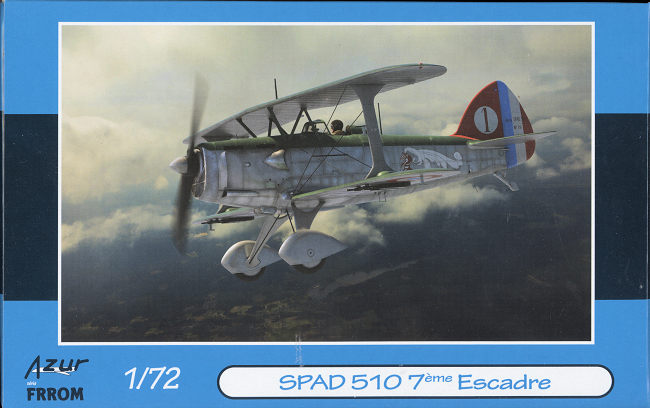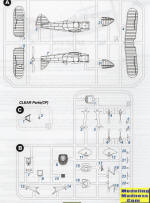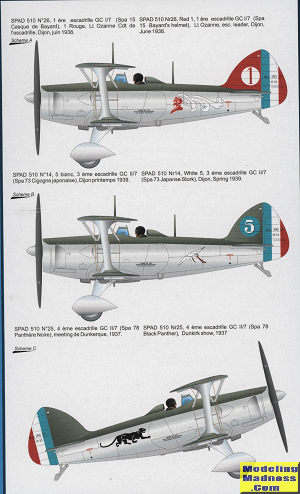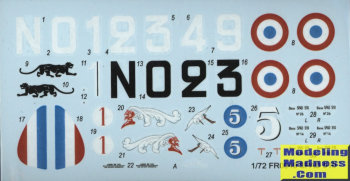
Azur/FRROM 1/72 SPAD 510 '7eme Escadrille'
| KIT #: | FR 0049 |
| PRICE: | $ |
| DECALS: | Three options |
| REVIEWER: | Scott Van Aken |
| NOTES: | . |

| HISTORY |
.The Blériot-SPAD S.510 was designed by André Herbemont to meet a 1930 French requirement for a single seat fighter. The new fighter was required to have a speed of 325 km/h (202 mph; 175 kn) at an altitude of 3,500 m (11,500 ft) (later increased to 350 km/h (220 mph; 190 kn) at the same height), with an armament of either four machine guns, one 20 mm cannon and two machine guns, or two cannon. Herbemont's design was based on his earlier S.91, and of the 11 designs submitted to meet the requirement, was the only biplane.
The SPAD 510 was of all-metal construction, with fabric-covered wings and tail, and a monocoque rear fuselage. The aircraft had a fixed conventional landing gear, which had a reputation for being fragile in service, with faired mainwheels and a tailskid. The aircraft was powered by a Hispano-Suiza 12Xbrs liquid-cooled V12 engine rated at 690 hp (510 kW) driving a two-bladed wooden propeller. Armament consisted of four 7.5 mm MAC 1934 machine guns mounted under the lower wing (the prototype carried the same armament, but with two guns in the fuselage). The last two production SPAD 510s were fitted with a Hispano-Suiza 12Xcrs engine, allowing a Hispano-Suiza 20 mm cannon to be mounted between the engine's cylinder banks, and firing through the propeller.
The sole prototype first flew on 6 January 1933. Flight testing revealed handling problems which resulted in the aircraft's centre fuselage being lengthened by 40 cm (16 in) and its vertical tail surfaces being enlarged. During evaluation in 1935 against the already in production Dewoitine D.500 at the Centre d'expériences aériennes militaires (CEAM), the French military aviation research centre at Reims, the SPAD 510 demonstrated superior manoeuvrability and climb rate. As a result, an order for 60 aircraft was placed on 30 August 1935.
Performance was similar to the British Gloster Gladiator. The S.510's armament generally consisted of 4 machine guns (installed as either a combination of 2 fuselage-mounted guns, plus 2 in under-wing gondolas or with all 4 in under-wing gondolas). This gave it a much heavier attack capability than most earlier biplane fighters and equalled that of the final biplanes used by the British and Italians, the Gladiator and Fiat CR.42 Falco. The S.510 was doomed to obsolescence before it even flew, although when it was designed many pilots and experts strongly believed that biplanes would prove better fighters than monoplanes because of their tighter turning circles. Despite its strengths, the S.510 only enjoyed about a year of usefulness. An adequate fighter for 1936, it was quickly outclassed by the new more modern monoplanes developed by Germany, Britain, and France. It had fixed landing gear as well as a weak fuel system and undercarriage.
| THE KIT |
 As
with all Azur/FRROM kits, this one is designed in France and produced by
MPM/Special Hobby in the Czech Republic. Parts detailing is excellent on the two
grey and one clear sprue. I did notice a bit of a shallow area on the fairly
thick bits, but nothing major. No photo etch with this one, which should please
some. The cockpit is fairly Spartan as was the norm for the day. There is a
floor section onto which one fits the fore and aft bulkheads, instrument panel,
seat and control stick. This then fits into the fuselage halves, which have
sidewall detail.
As
with all Azur/FRROM kits, this one is designed in France and produced by
MPM/Special Hobby in the Czech Republic. Parts detailing is excellent on the two
grey and one clear sprue. I did notice a bit of a shallow area on the fairly
thick bits, but nothing major. No photo etch with this one, which should please
some. The cockpit is fairly Spartan as was the norm for the day. There is a
floor section onto which one fits the fore and aft bulkheads, instrument panel,
seat and control stick. This then fits into the fuselage halves, which have
sidewall detail.
With the halves closed, the lower wings and tailplanes along with the forward cowling are fit. Instructions then show the gunsight and windscreen being attached, though you may wish to wait until after painting for this. Next, the cabine and interplane struts are attached, followed by the upper wing. I'd recommend only tacking on the upper wing until after rigging. Next are the landing gear legs and the wheel/spat combination.
 The
instructions then have you attach the lower wing guns and various small wing and
fuselage bits. Next is rigging. The wire location points on the wings are
delineated and really only need to be drilled out a bit to be useful. None of
the attachment points on the fuselage are equally marked, but it should be
fairly easy to locate those. Instructions call for .35mm wire for the wings and
landing gear. Final step is attaching the radio masts and the prop. Note that
one option has no masts so those holes will need filled.
The
instructions then have you attach the lower wing guns and various small wing and
fuselage bits. Next is rigging. The wire location points on the wings are
delineated and really only need to be drilled out a bit to be useful. None of
the attachment points on the fuselage are equally marked, but it should be
fairly easy to locate those. Instructions call for .35mm wire for the wings and
landing gear. Final step is attaching the radio masts and the prop. Note that
one option has no masts so those holes will need filled.
The instruction booklet is in full color and offers Gunze
paint references. All t hree
options are in aluminum with khaki brown upper surfaces. This shade needs to be
mixed. Note that the fuselage is metal so the aluminum for that will be a bit
different from the aluminum fabric surfaces. All three planes are from the same
basic unit so differ only in unit markings and colors. The decal sheet is very
nicely done and should prove to be quite thin.
hree
options are in aluminum with khaki brown upper surfaces. This shade needs to be
mixed. Note that the fuselage is metal so the aluminum for that will be a bit
different from the aluminum fabric surfaces. All three planes are from the same
basic unit so differ only in unit markings and colors. The decal sheet is very
nicely done and should prove to be quite thin.
| CONCLUSIONS |
Though a type of which few outside of France are aware, the type served when needed and is a plane that should be a part of any interwar aircraft collection.
| REFERENCES |
https://en.wikipedia.org/wiki/Bl%C3%A9riot-SPAD_S.510
August 2022
Thanks to www.FRROM.com for the review kit. You can get yours by contacting them direct or via an internet search.
Copyright ModelingMadness.com. All rights reserved. No reproduction in part or in whole without express permission.
If you would like your product reviewed fairly and fairly quickly, please contact the editor or see other details in the Note to Contributors.